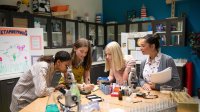Building Community Through Collaboration at the Start of the School Year
Teachers can begin to foster a strong classroom community by having students work together on meaningful activities.
Your content has been saved!
Go to My Saved Content.A few years ago, on the first day of school, I assigned seats to my physics students, and we started the year with a competition. I wanted to have table-based group members get to know each other, and I wanted to see them work together before we jumped into physics content. They’d be working on lab assignments together throughout the year and collaborating with tablemates for the remainder of the quarter.
So, to start making connections, I posed a challenge: build a spaghetti tower in 20 minutes that can hold a marshmallow in place using dry spaghetti sticks, a length of masking tape, and a length of string. The group whose tower holds the marshmallow the highest in the air wins.
There was no reward for winning, and the activity was not tied to a grade, so I was surprised to see how much students bought into it. The classroom was filled with the sounds of students talking with each other. They got up on the tables as their towers grew higher and higher.
In the end, the activity was a success—we had 10 spaghetti towers, each of them built with a different approach—and students had a good time working with each other. The morale stayed high across class periods and got me thinking about ways to consistently structure the first weeks of school to forge strong connections that carry students through collaborative assignments year-round.
The Importance of Community
One of the hardest things to do as a teacher is build community, especially among strangers who, like my ninth graders, may be entering high school from different middle schools. What we do in the beginning of the year can have long-term impacts on students’ sense of belonging, so it’s worth devoting more time to community building at the start of the school year, pushing beyond the usual icebreakers to intentionally foster a spirit of collaboration in the classroom.
There’s a lot to learn from an activity like the spaghetti tower competition, which only took one class period. By giving students the chance to not only get to know each other but practice working together before the pressure of academic grades sets in, we can boost academic and social and emotional learning long-term.
Implementing the Approach
I follow a general structure, building on the spaghetti tower, that I invite you to modify. For the first few days of school, I have table groups change daily—and randomly. Students work in teams to compete in a series of low-stakes group tasks that encourage out-of-the-box thinking and have multiple solutions, like the spaghetti tower, so that they have to engage in discussion and problem-solving.
Tasks should be fun—and hands-on if possible. The tasks I use change each year, but I take a lot of inspiration from the show Taskmaster as well as online teacher accounts that offer content showing how other educators have adapted the show in their classrooms.
I end each day with a class discussion followed by guided individual self-reflection and goal setting. These processes are key to taking these tasks and using them to lay the groundwork for strong communication and collaboration skills throughout the year. When we help students to gain an awareness of their proficiency in relational learning, they’re better able to reflect on and practice those skills across time.
Students might reflect, for example, on how they can thrive when working with others toward a common goal, as well as what they struggle with and can work on. For some, it may be hard not to dictate the conversation. For others, it may be that they are uncomfortable speaking at all. Many struggle with justifying their reasonings to their group members, and disagreements may result.
For everyone, this metacognition—and the goal setting it can lead to—positions them to more intentionally engage with each other, in addition to course content.
A Collaborative Education
Taking some time at the start of the year to engage in these community- and skill-building practices forges connections among diverse learners and is just one way that we can structure learning environments that are not dominated by status.
We want to build classrooms in which students see the value in different voices and points of view, ones where equitable learning and participation can occur. In doing so, perhaps we as teachers can help break the pattern of harmful hierarchies that can appear in our classrooms by creating spaces where unlikely friendships can bloom.
Entering high school can be scary and takes time to get used to. And even when students aren’t new to the school, the start of a new year brings with it novelty and transition, no matter what grade students are entering. For that reason, students deserve time to adjust to their surroundings and each other before they are faced with academic pressure. The above strategies offer ways into creating a safe, productive learning environment, setting the tone for the rest of the year while supporting the development of real-life skills that will serve students well throughout school and beyond.
